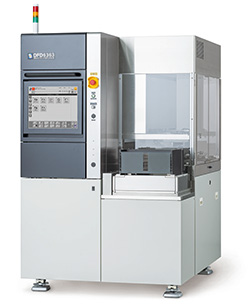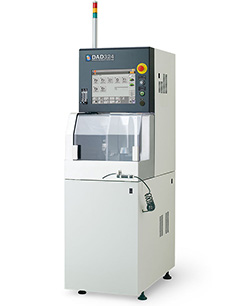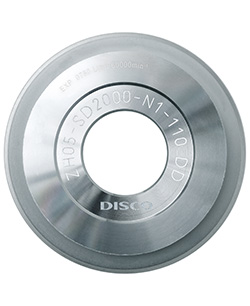Cutting Process Using Blades
Blade dicing
Process outline of the cutting process using blades
Dicing (cutting process using a blade) is a processing method that targets a flat substrate with a thickness of approx. 10 mm or below, and cutting or grooving is performed using a dicing blade (blade for the purpose of cutting).
A dicing blade is a whetstone that uses synthentic diamonds as abrasives, and has an outer diameter of around 50 mm and is around 0.01 - 0.05 mm thick. There are various models that have different abrasive sizes, bonds, and shapes. These dicing blades are rotated at high speeds, and a line is cut by pressing the blade against the processing target substrate at a constant speed, and cutting is performed.

During processing, water (city water or pure water) is supplied to the target in order to cool the processing point and to remove cutting particles. By cutting at a set pitch, it is possible to process the material into thin rectangles. Following this, by rotating the processing table by 90°, the target material can be cut into small cubes. As the target material is cut into squares (to dice = to cut into the shape of dice), it is called a dicing saw.
Precision processing equipment used
-

Fully Automatic Dicing Saw
Fully automatic cutting process equipment using a blade
-

Automatic dicing Saw
Automatic cutting process equipment using a blade
Fully Automatic Dicing Saw
The fully automatic dicing saws that are currently being sold come with various automation functions. Mainly, transfer, automatic cut position recognition, and cleaning functions are installed, and the target material can be managed per cassette.
Automatic Dicing Saw
These processing equipment require an operator to supply the target to be processed. An automatic cut position recognition function is installed.
Precision Processing Equipment Used
Main targets of the cutting process using a blade
- Semiconductor wafer cutting
- Semiconductor package cutting
- Processing of devices that use all types of electronic or optical components

